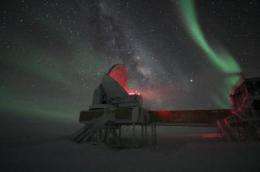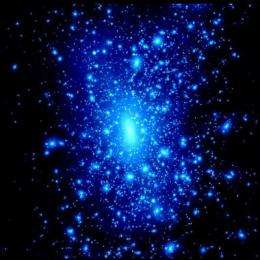Leading the quest to crack cosmological mysteries

Sometimes a scientist can only laugh in the face of a seemingly insurmountable challenge.
Such is the case with cracking the mystery of dark energy and its repulsive gravity, which is causing the expansion of the universe to accelerate.
"People don't even get the term 'repulsive gravity' because the defining feature of gravity is that it's attractive," says Michael Turner, director of the Kavli Institute for Cosmological Physics. "What do you mean, repulsive gravity? Do you mean the theory is repulsive?" he jokes.
Turner calls dark energy "the most profound mystery in all of science." Cracking the problem requires collaborations of original thinkers working beyond the limits of current theories. That's why dark energy is one of three cosmological puzzles that the Kavli Institute will tackle over the next five years with $17 million in new funding from the National Science Foundation as a Physics Frontiers Center.
Also high on the institute's research agenda are the riddles of dark matter and cosmic inflation. Along with dark energy, these are the three pillars of modern cosmological theory, "and none of them can be explained with physics that we know," Turner says. "They're all pointing to new physics."

During its first decade as a Physics Frontier Center, the Kavli Institute helped to establish the current cosmological paradigm. The Institute, originally called the Center for Cosmological Physics, was founded in 2001 with a $15 million NSF grant. The Institute is launching its second decade with 21 key collaborators around the country and 15 institutional partners, including Argonne National Laboratory and Fermi National Accelerator Laboratory.
The NSF created the Physics Frontiers Centers program to make significant advances at some of the most important intellectual frontiers in diverse physics subfields, says Joseph Dehmer, director of NSF's division of physics.
"By all measures, this has happened, and the 10 PFCs now operating reflect the extremely high standards of scholarship and synergy hoped for," Dehmer says. "An unexpected and most welcome benefit is that the PFCs act as talent magnets, drawing high levels of talent into physics. Another not unexpected benefit is that the triennial PFC competition constitutes a serious, high-level discussion across the subfields of physics — a rare 'unity of physics' event in an increasingly specialized field."
Argonne is a new partner in the UChicago PFC. Argonne and Kavli Institute scientists will develop large-scale cosmological simulations on the laboratory's supercomputers, as well as sensitive new detectors for the South Pole Telescope, which studies the cosmic microwave background radiation leftover from the birth of the universe. Kavli Institute scientists will investigate the dark energy question with the SPT and the Dark Energy Survey. The latter project, led by Fermilab, will collect data on approximately 300 million galaxies spanning two-thirds the history of the universe in order to measure dark energy with new precision.
New form of matter?
The mystery of dark matter may be easier to solve. Kavli Institute scientists hope to accomplish this feat within the next decade. They suspect that dark matter is made of a new form of matter, something that does not consist of quarks, neutrons or protons.
Dark matter may reveal itself through any or all of three means: direct detection via ground-based detectors at the Chicagoland Observatory for Underground Particle Physics (COUPP), indirect detection in the galaxy halo via satellites, and production of the particles at the Large Hadron Collider at CERN, the European particle physics laboratory.

"Right now, there is confusion — claims of possible detections, counter-claims, and spirited debate — and the time is ripe to solve the dark matter problem. Our PFC hopes to shed critical light on dark matter," says Rocky Kolb, the University's Arthur Holly Compton Distinguished Service Professor in Astronomy & Astrophysics, who leads the PFC's dark matter effort.
Cosmic inflation is a different kind of problem. It has emerged as the most important cosmological concept since the Big Bang theory, but many of its claims have not yet been thoroughly tested. Inflation proposes that the universe expanded extremely rapidly in a tiny fraction of a second after the Big Bang. Such a swift expansion would explain some important questions that Big Bang theory alone has been unable to answer.
"We have some circumstantial evidence that inflation took place, but we'd like to make the case very strongly," says John Carlstrom, the S. Chandrasekhar Distinguished Service Professor in Astronomy & Astrophysics. A more direct indication of inflation would be to look for a minute sign of polarization in the cosmic microwave background, the afterglow of the Big Bang.
For the last decade, center scientists including Carlstrom and the late Bruce Winstein have been developing a technology capable of measuring this polarization. Now they need to deploy that technology to see what they can find.
The successful Kavli Institute proposal for the Physics Frontiers Center was more than two years in the making and included significant support from the university administration and behind-the-scenes personnel.
Winstein, the Samuel K. Allison Distinguished Service Professor in Physics and founder of the original PFC, also played a big role in developing the proposal for renewed funding. Winstein, who lost a four-year battle with cancer last February, worked on the proposal until his last days, Turner says.
"During the last months of his life, he was parceling out his time only to the most important things, and we got a lot of his time. Our PFC is part of Bruce's legacy."
Provided by University of Chicago

















